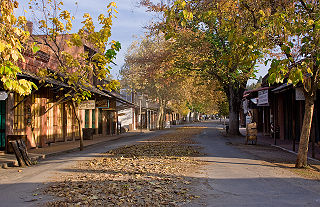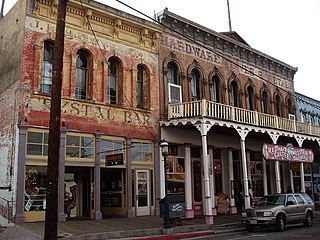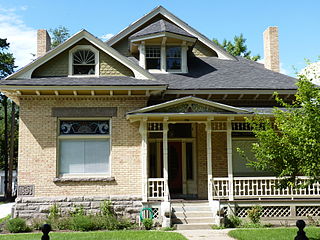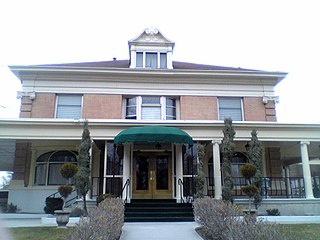
Trail Ridge Road is the name for a stretch of U.S. Highway 34 that traverses Rocky Mountain National Park from Estes Park, Colorado in the east to Grand Lake, Colorado in the west. The road is also known as Trail Ridge Road/Beaver Meadow National Scenic Byway.

Columbia State Historic Park, also known as Columbia Historic District, is a state park unit and National Historic Landmark District preserving historic downtown Columbia, California, USA. It includes almost 30 buildings built during the California Gold Rush, most of which remain today. It was declared a National Historic Landmark in 1961.

Bent's Old Fort is an 1833 fort located in Otero County in southeastern Colorado, United States. A company owned by Charles Bent and William Bent and Ceran St. Vrain built the fort to trade with Southern Cheyenne and Arapaho Plains Indians and trappers for buffalo robes. For much of its 16-year history, the fort was the only major white American permanent settlement on the Santa Fe Trail between Missouri and the Mexican settlements. It was destroyed in 1849.

The Colorado Governor's Mansion, also known as the Cheesman-Boettcher Mansion, is a historic U.S. mansion in Denver, Colorado. It is located at 400 East 8th Avenue. On December 3, 1969, it was added to the U.S. National Register of Historic Places. It is open free-of-charge for scheduled tours, and also hosts special public events.

Old Colorado City, formerly Colorado City, was once a town, but it is now a neighborhood within the city of Colorado Springs, Colorado. Its commercial district was listed on the National Register of Historic Places in 1982. It was founded during the Pikes Peak Gold Rush of 1859 and was involved in the mining industry, both as a supply hub and as a gold ore processing center beginning in the 1890s. Residents of Colorado City worked at some of the 50 coal mines of the Colorado Springs area. It was briefly the capital of the Colorado Territory. For many years, Colorado Springs prohibited the use of alcohol within its border due to the lifestyle of Colorado City's opium dens, bordellos, and saloons. It is now a tourist area, with boutiques, art galleries, and restaurants.

Virginia City Historic District is a National Historic Landmark District encompassing the former mining villages of Virginia City and Gold Hill, both in Storey County, as well as Dayton and Silver City, both to the south in adjacent Lyon County, Nevada, United States. Declared a National Historic Landmark in 1961, the district is one of only six in the state of Nevada.

St. Elmo is a ghost town in Chaffee County, Colorado, United States. Founded in 1880, St. Elmo lies in the heart of the Sawatch Range, 20 miles (32 km) southwest of Buena Vista and sits at an elevation of 9,961 feet (3,036 m). Nearly 2,000 people settled in this town when mining for gold and silver started. The mining industry started to decline in the early 1920s, and in 1922 the railroad discontinued service. The community is listed on the National Register of Historic Places as the St. Elmo Historic District. It is one of Colorado's best preserved ghost towns.

The Samuel L. Smith House is located at 5035 Woodward Avenue in Midtown Detroit, Michigan. It was also known as the Schools Annex. It was listed on the National Register of Historic Places in 1986.

Allen House, also known historically as The Terraces, is an historic house at 2 Solomont Way on the South Campus of the University of Massachusetts Lowell in Lowell, Massachusetts. Built about 1854, it is one of the city's finest early examples of Italianate architecture. In the early 20th century, it was the home of Charles Herbert Allen, a prominent local politician. Since 1957, it has been owned by the University of Massachusetts Lowell; restored in the 2000s, it houses a gallery and event space used for university programs. It was listed on the National Register of Historic Places in 1982.

The Kauffman House is a rustic log house in Grand Lake, Colorado that functioned as a hotel from its construction in 1892 to 1973. It was built by Ezra Kauffman, a local prospector, trapper and builder of log structures who operated it as a hotel until his death in 1920 at age 71. It was then operated as a summer hotel by his widow and daughters until World War II.
Kauffman House may refer to:

Hillside, also known as the Charles Schuler House, is a mansion overlooking the Mississippi River on the east side of Davenport, Iowa, United States. It has been individually listed on the National Register of Historic Places since 1982, and on the Davenport Register of Historic Properties since 1992. In 1984 it was included as a contributing property in the Prospect Park Historic District.

The former Riede's City Bakery building is located on East Hyman Street in Aspen, Colorado, United States. It is a small wooden commercial building erected in the 1880s. In 1987, it was listed on the National Register of Historic Places.

The Charles E. Loose House is a historic house located in Provo, Utah, United States. The house was individually nominated for listing on the National Register of Historic Places in 1982 but was not listed due to owner objection. It later was included as a contributing property in the Provo East Central Historic District.

The Bowles–Cooley House is located at the corner of West Francis and North First streets in Aspen, Colorado, United States. It is a brick structure in the Queen Anne architectural style built during the 1880s. In 1987 it was listed on the National Register of Historic Places along with many other historic properties in the city.

The Jesse Knight House, also known as the Knight Mansion, is a historic house in Provo, Utah, United States built for Jesse Knight. It was built in 1905, and added to the National Register of Historic Places in 1982. This home was designated to the Provo City Historic Landmarks Register on June 19, 1996.

Rico Town Hall or Rico City Hall is a multi-purpose building in the tiny mountain mining town of Rico, Colorado. Rico was formerly the county seat of Dolores County, and the city hall was built as the Dolores County Courthouse in 1892 by a "Mr. Carpenter." At the time Rico was in the middle of a gold boom and had a population of 4,000. Over time the county's population shifted to Dove Creek, and after 53 years the county seat moved in 1946. The courthouse remained vacant until 1955, when it was transferred to Rico for town offices and meeting space.

Sunrise was a company mining town of the Colorado Fuel and Iron Company located in Platte County, Wyoming. The entire site of the former mining district and town is on the National Register of Historic Places.

Wheeler Bank is a historic building located on Manitou Avenue in Manitou Springs, Colorado built by Jerome B. Wheeler. It is on the National Register of Historic Places. Over the course of its history, the building has been a financial institution, auditorium and retail business.

Flower-Vaile House is a historic house in North Capitol Hill, Denver, Colorado. The house was designed by Balcombe and Rice and built by D. S. Gray. It was designated a Denver Landmark on October 13, 1981 and was listed on the National Register of Historic Places on October 21, 1982. Richard R. Brettel described the house in Historic Denver as a prime example of "decorative or surface style eclecticism added to the basic Queen Anne Street house — very common in Denver by the mid- to late-1880s."























